Deborah Swift's Blog, page 36
March 21, 2015
The Wicked Lady – Katherine Fanshawe
[image error]
I am not the first writer to be inspired by the life and legend of Lady Katherine Fanshawe.
The first novel based on her life was by Magdalen King-Hall who wrote a book called The Life and Death of the Wicked Lady Skelton in 1945. I have a copy and it is exciting reading, though long-winded in the telling by today’s standards. The book was a smash hit in its day and was made into a film - The Wicked Lady.
The film starred Margaret Lockwood in the title role as a nobleman's wife who secretly becomes a highwayman to relieve her life of boredom. The mystery of why she would take such an extreme action was the sensation of its day – women were supposed to be safe at home doing the housekeeping! The film had one of the top audiences ever for a film of its period, 18.4 million – a staggering number. I can remember my mother talking about it as one of her favourite films.
It was one of the Gainsborough melodramas, a sequence of very popular films made during the 1940s in wartime Britain. They provided pure escapism from the deprivation of WWII, with lavish sets and costumes and period settings, and the films were often based on historical novels.
Here is the trailer for the 1945 film – great costumes, but from it you get the melodramatic flavour of the plot. In fact, before it could be released in the US, re-shooting was required as the women's bodices were very low-cut and showed too much cleavage for the American censors.
It was such a hit that the film was re-made in 1983 and starred Faye Dunaway in the lead role. (Poster from www.moviepostercompany.co.uk) The film was a disaster and earned Faye Dunaway an award for the Worst Actress!
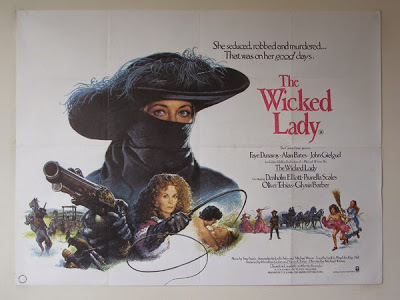
In my retelling of the story I have stuck to historical facts more than King-Hall did, including keeping the original names. Research into the background of the English Civil War provided me with plausible plot devices that enabled me to stick with the history more closely. However, as this is a novel for younger readers (14+) I wanted to retain the swashbuckling feel if possible, without making it into a melodrama. My story is told over three stand-alone books with three different points of view, the first book, Shadow on the Highway, is told from the point of view of Abigail, Lady Katherine’s deaf maidservant. You can find out more about how I researched her here.
This post first appeared on the Let Them Read Books Blog. Why not visit the site for more historical fiction, and interesting guest posts.
Published on March 21, 2015 03:35
March 8, 2015
Nursing in the 1940's and 50's - Fetch Nurse Connie
I am thrilled to welcome Jean Fullerton to my blog today, to chat about her latest book and the way in which she researched and wrote the story. Known for her wonderful Powerpoint presentations about East End London life, Jean brings all her research and life experience in the NHS to her books about 1940's and 50's nursing.
 Fetch Nurse Connie will be the fifth book in the East End Nurses series. How have circumstances in healthcare changed for Millie and Connie since the first book?
Fetch Nurse Connie will be the fifth book in the East End Nurses series. How have circumstances in healthcare changed for Millie and Connie since the first book?
I purposely set Call Nurse Millie in the years after the end of the WW2 and before the introduction of the NHS in 1948 so people could see what the system of health care before the NHS was actually like. In the first book of the series Millie and Connie are employed by a local Nursing Association which is a voluntary organisation supported by subscriptions and fundraising rather than central funding. The second book All Change for Nurse Millie starts on 5th July 1948, the day the NHS came into being so I could show the changes to the new system and some of the problems it had from the very start.
As Connie is Millie’s closest friend and we meet her a great deal in Millie’s story it seemed natural to tell her story in Fetch Nurse Connie, during the same time period. Like Millie’s, Connie’s story starts on VE-Day 1945 when the old health system was still in place so we see Connie not only grappling with the her patients illnesses but also the social conditions of the time.
Your books are impeccably researched. What are the two most valuable resources you use for discovering about medicine in the 1950's?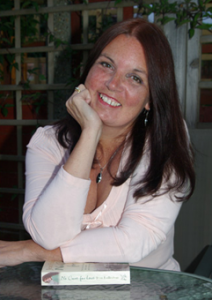 Thank you for saying so, Deborah. Unlike my previous 19th century books the East London Nurses’ Series is within living memory so I have the great privilege of being able to speak to nurses who worked in East London during that time. However, my most valuable research resources are my collection of 1930s, 40s and 50s nursing and midwifery text books. These include books on child health, contraception, midwifery, nursing dictionaries and a 1945 doctor’s prescribing dictionary, all of which I have to hand all the time. The most valuable of these books is the 1947 edition of Merry and Irven’s District Nursing. This was the text book all trainee Queen’s Nurses’ would have bought. It has everything from clinical procedures to the various charitable institutions of the time like the Sick Children’s’ Fund and the Destitute Relief Board. It also sets out how fees were calculated and the proper administration of a local Nursing Association. It was totally invaluable in helping me breathe life into district nursing during that period. There is also a breakdown of the way the new Welfare State was to be implemented and how much the individuals had to contribute in to the National Insurance Scheme before they were entitled to receive benefits. I also think I must have every nurses biography of the 20th century and a few before.
Thank you for saying so, Deborah. Unlike my previous 19th century books the East London Nurses’ Series is within living memory so I have the great privilege of being able to speak to nurses who worked in East London during that time. However, my most valuable research resources are my collection of 1930s, 40s and 50s nursing and midwifery text books. These include books on child health, contraception, midwifery, nursing dictionaries and a 1945 doctor’s prescribing dictionary, all of which I have to hand all the time. The most valuable of these books is the 1947 edition of Merry and Irven’s District Nursing. This was the text book all trainee Queen’s Nurses’ would have bought. It has everything from clinical procedures to the various charitable institutions of the time like the Sick Children’s’ Fund and the Destitute Relief Board. It also sets out how fees were calculated and the proper administration of a local Nursing Association. It was totally invaluable in helping me breathe life into district nursing during that period. There is also a breakdown of the way the new Welfare State was to be implemented and how much the individuals had to contribute in to the National Insurance Scheme before they were entitled to receive benefits. I also think I must have every nurses biography of the 20th century and a few before.
Apart from Millie, who is your favourite character to write? Is he/she constructed around a real person from the past?I actually enjoy writing her friend Connie, who is the heroine of the new book. She has a very different story and other issues in her professional and personal life to cope with. Unlike Millie she is part of a large East End family, very like my own. After her fiancé’s home-coming takes and unexpected turn Connie finds herself spending a great deal of time trying to put her heartache behind her and convince her mother and two sisters that there’s more to life than marriage and children.I never consciously construct a character around anyone in particular but I hope Connie, like Millie, is a little bit like the nurse I strive to be.
What would surprise Connie and Millie most about nursing today?As a registered district nurse with 20 years’ experience working in East London I’m sad to say that today ‘care’ sometimes seems missing out of the equation. Not by nurses’ I might say. I teach nursing at a London University and can assure you the vast majority of the nurses I nurture through their 3 year’s training are kind and compassion and I’d be happy for them to nurse any of my nearest and dearest. Sadly, it’s the overburdened NHS full of targets, statistics and research that sometimes put unbearable pressure on them. In Millie and Connie’s day a nurse was responsible for all their patients’ needs. This included housework, personal care and nutrition along with the more obvious nursing tasks such as dressings and medication. However, I’m sure she’d be amazed at the range of drugs now available – especially those to regular body systems such as diabetes, high blood-pressure and pain relief plus being able to undertake such complex operation as open heart surgery and joint replacements.
How carefully do you plan your books? Do you have a strong outline, or do the characters know where they want to go?
Because I weave at least six patients’ stories through Connie’s over-arching story I plan my novels very carefully on a colour coded table. This allows me to space out Connie’s meeting with her patients, family and her ex-fiancé Charlie. I can also see, for example of there are too many scenes with her family bunched together or if there’s too much space between her patients as we see their stories.Of course it changes as I get to know the characters and ideas come to me but it gives me a place to start.
Thanks for asking me to drop by Deborah and for anyone who might want to read Connie’s story here’s a quick insight.Fetch Nurse Connie.Connie Byrne, a nurse in London's East End working alongside Millie Sullivan from Call Nurse Millie, is planning her wedding to Charlie Ross, set to take place as soon as he returns from the war. But when she meets him off the train at London Bridge, she finds that his homecoming isn't going to go according to plan.Connie's busy professional life, and the larger-than-life patients in the district, offer a welcome distraction, but for how long?Available from Orion Fiction on kindle, paperback and hardback on 4th June 2015Click on the bookcover to pre-order.Easter with Nurse Millie out 19th March
Fetch Nurse Connie out 4th June 2015.
All Change for Nurse Millie
Christmas with Nurse Millie e-novella.
Call Nurse Millie.Website: http://www.jeanfullerton.com
 Fetch Nurse Connie will be the fifth book in the East End Nurses series. How have circumstances in healthcare changed for Millie and Connie since the first book?
Fetch Nurse Connie will be the fifth book in the East End Nurses series. How have circumstances in healthcare changed for Millie and Connie since the first book?I purposely set Call Nurse Millie in the years after the end of the WW2 and before the introduction of the NHS in 1948 so people could see what the system of health care before the NHS was actually like. In the first book of the series Millie and Connie are employed by a local Nursing Association which is a voluntary organisation supported by subscriptions and fundraising rather than central funding. The second book All Change for Nurse Millie starts on 5th July 1948, the day the NHS came into being so I could show the changes to the new system and some of the problems it had from the very start.
As Connie is Millie’s closest friend and we meet her a great deal in Millie’s story it seemed natural to tell her story in Fetch Nurse Connie, during the same time period. Like Millie’s, Connie’s story starts on VE-Day 1945 when the old health system was still in place so we see Connie not only grappling with the her patients illnesses but also the social conditions of the time.
Your books are impeccably researched. What are the two most valuable resources you use for discovering about medicine in the 1950's?
 Thank you for saying so, Deborah. Unlike my previous 19th century books the East London Nurses’ Series is within living memory so I have the great privilege of being able to speak to nurses who worked in East London during that time. However, my most valuable research resources are my collection of 1930s, 40s and 50s nursing and midwifery text books. These include books on child health, contraception, midwifery, nursing dictionaries and a 1945 doctor’s prescribing dictionary, all of which I have to hand all the time. The most valuable of these books is the 1947 edition of Merry and Irven’s District Nursing. This was the text book all trainee Queen’s Nurses’ would have bought. It has everything from clinical procedures to the various charitable institutions of the time like the Sick Children’s’ Fund and the Destitute Relief Board. It also sets out how fees were calculated and the proper administration of a local Nursing Association. It was totally invaluable in helping me breathe life into district nursing during that period. There is also a breakdown of the way the new Welfare State was to be implemented and how much the individuals had to contribute in to the National Insurance Scheme before they were entitled to receive benefits. I also think I must have every nurses biography of the 20th century and a few before.
Thank you for saying so, Deborah. Unlike my previous 19th century books the East London Nurses’ Series is within living memory so I have the great privilege of being able to speak to nurses who worked in East London during that time. However, my most valuable research resources are my collection of 1930s, 40s and 50s nursing and midwifery text books. These include books on child health, contraception, midwifery, nursing dictionaries and a 1945 doctor’s prescribing dictionary, all of which I have to hand all the time. The most valuable of these books is the 1947 edition of Merry and Irven’s District Nursing. This was the text book all trainee Queen’s Nurses’ would have bought. It has everything from clinical procedures to the various charitable institutions of the time like the Sick Children’s’ Fund and the Destitute Relief Board. It also sets out how fees were calculated and the proper administration of a local Nursing Association. It was totally invaluable in helping me breathe life into district nursing during that period. There is also a breakdown of the way the new Welfare State was to be implemented and how much the individuals had to contribute in to the National Insurance Scheme before they were entitled to receive benefits. I also think I must have every nurses biography of the 20th century and a few before.Apart from Millie, who is your favourite character to write? Is he/she constructed around a real person from the past?I actually enjoy writing her friend Connie, who is the heroine of the new book. She has a very different story and other issues in her professional and personal life to cope with. Unlike Millie she is part of a large East End family, very like my own. After her fiancé’s home-coming takes and unexpected turn Connie finds herself spending a great deal of time trying to put her heartache behind her and convince her mother and two sisters that there’s more to life than marriage and children.I never consciously construct a character around anyone in particular but I hope Connie, like Millie, is a little bit like the nurse I strive to be.
What would surprise Connie and Millie most about nursing today?As a registered district nurse with 20 years’ experience working in East London I’m sad to say that today ‘care’ sometimes seems missing out of the equation. Not by nurses’ I might say. I teach nursing at a London University and can assure you the vast majority of the nurses I nurture through their 3 year’s training are kind and compassion and I’d be happy for them to nurse any of my nearest and dearest. Sadly, it’s the overburdened NHS full of targets, statistics and research that sometimes put unbearable pressure on them. In Millie and Connie’s day a nurse was responsible for all their patients’ needs. This included housework, personal care and nutrition along with the more obvious nursing tasks such as dressings and medication. However, I’m sure she’d be amazed at the range of drugs now available – especially those to regular body systems such as diabetes, high blood-pressure and pain relief plus being able to undertake such complex operation as open heart surgery and joint replacements.
How carefully do you plan your books? Do you have a strong outline, or do the characters know where they want to go?
Because I weave at least six patients’ stories through Connie’s over-arching story I plan my novels very carefully on a colour coded table. This allows me to space out Connie’s meeting with her patients, family and her ex-fiancé Charlie. I can also see, for example of there are too many scenes with her family bunched together or if there’s too much space between her patients as we see their stories.Of course it changes as I get to know the characters and ideas come to me but it gives me a place to start.
Thanks for asking me to drop by Deborah and for anyone who might want to read Connie’s story here’s a quick insight.Fetch Nurse Connie.Connie Byrne, a nurse in London's East End working alongside Millie Sullivan from Call Nurse Millie, is planning her wedding to Charlie Ross, set to take place as soon as he returns from the war. But when she meets him off the train at London Bridge, she finds that his homecoming isn't going to go according to plan.Connie's busy professional life, and the larger-than-life patients in the district, offer a welcome distraction, but for how long?Available from Orion Fiction on kindle, paperback and hardback on 4th June 2015Click on the bookcover to pre-order.Easter with Nurse Millie out 19th March
Fetch Nurse Connie out 4th June 2015.
All Change for Nurse Millie
Christmas with Nurse Millie e-novella.
Call Nurse Millie.Website: http://www.jeanfullerton.com
Published on March 08, 2015 09:00
February 24, 2015
Award-winning author Charlotte Betts reveals her favourite English chateau
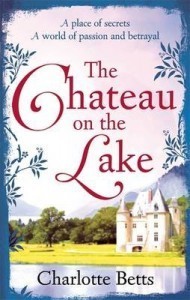
I have just finished Charlotte Betts' latest novel, Chateau on the Lake, which is yet another gripping romance from this award-winning novelist. I first came across Charlotte because she has written several books in one of my favourite periods - the seventeenth century, but for this novel we are invited to explore the 18th century and Revolutionary France.
After the death of her parents Madeleine Moreau must travel to France to search for the relatives she has heard of, but never met. The meeting proves disastrous and she is given shelter at Chateau Mirabelle, a breathtakingly beautiful castle which is home to the aristocrat Etienne D'Aubery. Of course there is a little competition for Madeleine's affections, with the handsome Jean Luc, and plenty of dark and sinister secrets in the Chateau's past.
Charlotte Betts recreates the detail of the period painstakingly, whilst still providing a pacy and satisfying romance. The sense of the course of the French revolution with all its horrors - the guillotine, the starving peasants, the mob violence - all these are faithfully depicted, whilst never losing the forward momentum of the plot. It is a hard thing to do, to juggle romance against such gritty realism, but Charlotte Betts does it seamlessly.
I wondered, after the attractions of France, which would be Charlotte's favourite English chateau, a place in which to spend a quiet afternoon -
Corfe Castle is one of my favourite historical sites to visit. We often holiday in Dorset and I love the way the castle is the focal point of the village. It's always been sunny when I've visited and I like to sit quietly in the sunshine and allow the tourists' voices fade away. If I close my eyes and listen to the echoes of time it's almost possible to unlock the secrets of the past. I conjure up a vision of Lady Mary Bankes who, when her husband was away, led the defence of the castle during a six week siege by the Parliamentarians. What a wonderful novel that would make! Perhaps I shall write about that one day.Charlotte
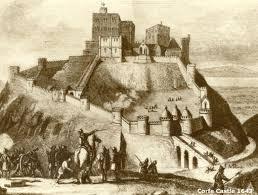
With her talk of English Civil War sieges, I might just beat her to it. (Only joking of course!)
Find out more about Charlotte Betts on her website
Published on February 24, 2015 06:56
February 18, 2015
Red Rose, White Rose - Joanna Hickson researches Cecily Neville
My article on Red Rose White Rose by Joanna Hickson - Queen of the Castle. is featured in the Historical Novel Society Magazine this month. You can find it here on their website if you are a member of the HNS. If you like historical fiction, why not join?

For those who are not members, here's a little insight...The article describes how Joanna Hickson's research for this densely researched novel took her on a journey to visit a number of castles where Cecily Neville lived, in order to build a picture and soak up the atmosphere. A heavy fall of snow made two particularly difficult. She tells us that Maxstoke Castle, a place where Cecily was under house arrest later in her life, was a classic four-square medieval moated castle, ‘a small jewel as opposed to a rambling fortress.’ Joanna explained, ‘The gates are still fortified with the iron-cladding installed by Cecily Neville's brother-in-law, Humphrey, 1st Duke of Buckingham and bear his cypher.' Here is Joanna's picture of that snowy day - there was no room for it in the article. Maxstoke CastleThe other difficult castle to visit was apparently Ludlow. Looking round these castles in the snow, she says, 'gave me a very good impression of the dangers faced by the inhabitants of a freezing, draughty castle in winter.’
Maxstoke CastleThe other difficult castle to visit was apparently Ludlow. Looking round these castles in the snow, she says, 'gave me a very good impression of the dangers faced by the inhabitants of a freezing, draughty castle in winter.’
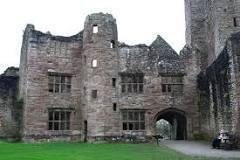 Ludlow CastleAccording to Joanna, ‘Fotheringhay was Cecily Neville's favourite castle. 'It is where Richard III was born and, a hundred years later, Mary Queen of Scots was beheaded – two monarchs whose tragic histories may have caused it's subsequent decline into a mere footprint in the soil of the Northamptonshire landscape.’
Ludlow CastleAccording to Joanna, ‘Fotheringhay was Cecily Neville's favourite castle. 'It is where Richard III was born and, a hundred years later, Mary Queen of Scots was beheaded – two monarchs whose tragic histories may have caused it's subsequent decline into a mere footprint in the soil of the Northamptonshire landscape.’
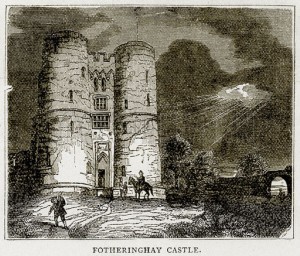
Cecily Neville is a fascinating character, and in Red Rose, White Rose we watch her mature against the background of constant in-fighting by her male relations. If you are a fan of the Wars of the Roses period, then this is a wonderful read. By the introduction of Cuthbert, Cecily's fictional illegitimate half-brother, we get an insight from a male as well as a female perspective into the feuding Plantagenets and their bloody battles for land and stronghold. Recommended.

For those who are not members, here's a little insight...The article describes how Joanna Hickson's research for this densely researched novel took her on a journey to visit a number of castles where Cecily Neville lived, in order to build a picture and soak up the atmosphere. A heavy fall of snow made two particularly difficult. She tells us that Maxstoke Castle, a place where Cecily was under house arrest later in her life, was a classic four-square medieval moated castle, ‘a small jewel as opposed to a rambling fortress.’ Joanna explained, ‘The gates are still fortified with the iron-cladding installed by Cecily Neville's brother-in-law, Humphrey, 1st Duke of Buckingham and bear his cypher.' Here is Joanna's picture of that snowy day - there was no room for it in the article.
 Maxstoke CastleThe other difficult castle to visit was apparently Ludlow. Looking round these castles in the snow, she says, 'gave me a very good impression of the dangers faced by the inhabitants of a freezing, draughty castle in winter.’
Maxstoke CastleThe other difficult castle to visit was apparently Ludlow. Looking round these castles in the snow, she says, 'gave me a very good impression of the dangers faced by the inhabitants of a freezing, draughty castle in winter.’
 Ludlow CastleAccording to Joanna, ‘Fotheringhay was Cecily Neville's favourite castle. 'It is where Richard III was born and, a hundred years later, Mary Queen of Scots was beheaded – two monarchs whose tragic histories may have caused it's subsequent decline into a mere footprint in the soil of the Northamptonshire landscape.’
Ludlow CastleAccording to Joanna, ‘Fotheringhay was Cecily Neville's favourite castle. 'It is where Richard III was born and, a hundred years later, Mary Queen of Scots was beheaded – two monarchs whose tragic histories may have caused it's subsequent decline into a mere footprint in the soil of the Northamptonshire landscape.’
Cecily Neville is a fascinating character, and in Red Rose, White Rose we watch her mature against the background of constant in-fighting by her male relations. If you are a fan of the Wars of the Roses period, then this is a wonderful read. By the introduction of Cuthbert, Cecily's fictional illegitimate half-brother, we get an insight from a male as well as a female perspective into the feuding Plantagenets and their bloody battles for land and stronghold. Recommended.
Published on February 18, 2015 03:11
February 10, 2015
Learning and Leisure - the disappearance of 'Night School'
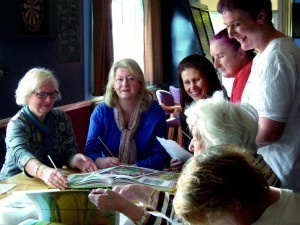
In the old days people went to 'Night School' to learn a new skill, like a language, or carpentry, or DIY, or car maintenance, and you had to book well in advance to secure your place. That idea morphed into 'Adult Education', and that into 'Adult and Community Education', as if by adding the word 'community', whole communities would suddenly be engaged in out of hours education. For the past couple of decades I have been a teacher for adults at day and evening classes and have noticed big changes in the way adults learn and are taught. Class numbers are dwindling, and the average age is getting older. Aren't younger people interested in leaning new skills, I wondered?
The first thing you notice if you turn up at a government-funded leisure class is the mounds of paperwork. The increase in paperwork was first highlighted as far back as 2008 in this article in The Guardian. On the obligatory termly feedback forms, learners ask over and over again for less paperwork, but their pleas are ignored, despite the fact this might be the only criticism they have of the class. The vast amount of paperwork is to ensure quality of teaching, an admirable aim, but remember, these are adult customers we are talking about, not children forced into a learning environment. If they don't feel the class meets their needs they can ask to choose another course, ask for a refund, or complain. Few do, as the quality of teaching is often excellent, with or without the 'peer review, mid-term survey 'etc etc.
Some of the classes are classes earn you a qualification, for example an NVQ or similar, but according to the Adult Learning Survey figures, only 25% of the classes are of this type. The rest are leisure learning classes such as 'Holiday French', 'Watercolour Painting', 'Guitar for Beginners'. These provide a social as well as an educational function, though the coffee breaks might well now be consumed by form-filling, as the learners puzzle over whether or not they really know how to play Scarborough Fair well enough to tick it off on their list of objectives, and whether or not playing to each other counts as evidence, or whether the tutor must video it.
The amount of paperwork has meant Adult Education teachers in subjects such as the Arts, Sport or subjects such as Yoga have given up with a system which demands they do initial assessments on people who don't want to be assessed. Adults who have come to a class to relax or because they failed in school find that their first lesson (even in Yoga) consists of an assessment of their current ability, (slightly scary) and that the whole scheme of paperwork is managed by, believe it or not - the school inspectors, Ofsted. Students are confronted by a 'what are your objectives' questionnaire, often when they are a total beginner to a subject. e.g.Q: 'Astronomy - what are your personal learning goals in this class?' A: 'Er...I would like to know more about the stars.'
The National Adult Learning Survey 2010 'has recorded a steep decline in non-formal and informal learning compared with previous NALS. Participation in formal learning is unchanged. The decline in non-formal learning coincides with the shift in public funding away from short courses in favour of longer courses leading to nationally recognised qualifications.'
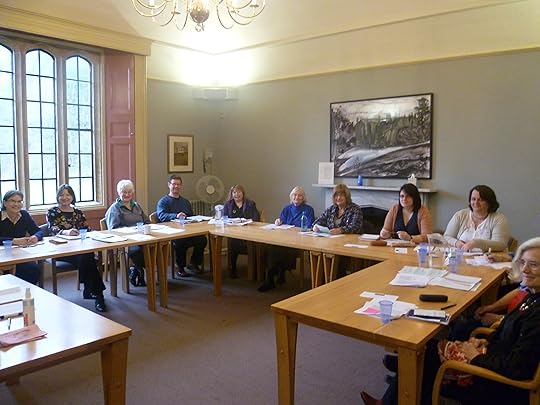
At the same time, there has been a huge rise in the number of people who now head for the U3A - the University of the Third Age. The U3A runs its classes as interest groups. There is no paperwork, and the teachers are unpaid volunteers. You can join as long as you are retired or semi-retired, and in these days of the internet, lots of people are semi-retired or work part-time from home. Many of the retired people who used to support Local Authority Adult Education classes have joined the U3A, and groups are thriving and bursting at the seams. This is for several reasons - first because the cost is so cheap to attendees - £1 or £1.50 a class, plus a nominal joining fee. Secondly, there is no paperwork to do and no exams. Thirdly, the classes (described as interest groups) are led by enthusiasts for their subject, who again are often excellent teachers, and the classes are designed to be guided by the needs of the attendees.
But the biggest rival of all to Adult Education and the U3A is the internet. Now you can tutor yourself in just about anything on-line. A friend of mine recently learnt how to french-polish a table via an online tutorial, including setting fire to the polish. He wasn't warned not to try it at home. In one way, this method of learning is extremely empowering. The emphasis is firmly on the learner motivating him/herself, and there is something to be said for making mistakes in the privacy of your own home where no-one will see you, or grade you out of 10.
So what is lost? In all these ways of learning the inspiration of a one-to-one relationship with a teacher/mentor. I can't imagine anyone will remember their online tutor in quite the same way as they remember someone they have actually had face-to-face contact with. I remember my teachers as people first, and as teachers second. (Thank you, Mrs Wells, Mr Thurloe, Mike Robson, Chris Bostock). Enthusiasm can come over online, but it is not the same as being galvanized by the personal attention of someone who sets you on fire to learn. With the internet method of learning we have to rely on inspiring ourselves, and perhaps that is a good thing, but perhaps we will miss the real-life contact with someone who cares about our progress as an individual.

The U3A method keeps a sharing relationship open, but runs the risk of tutors being unqualified or inexperienced in their subject. Health and Fitness courses in particular are much in demand with the older age-group, but the U3A has few members qualified enough to lead them. The Adult Education model focuses narrowly on judging quality of teaching by whether or not the forms are filled, and not on the invisible relationship between learner and teacher. The internet appeals massively to men, conspicuously absent at most of these classes, but engaging with learning online. There is a strong appeal to them in Doing It Yourself.
As a creative writing tutor, I have seen a big shift away from learning in class to learning online. Is this an advantage or disadvantage to the learner? What do you think? Is leisure learning important? If leisure learning classes were to disappear altogether, would anything be lost?
Published on February 10, 2015 06:55
February 6, 2015
Page-turning fiction - can it be memorable?
I've just finished a book I've been working on for about eighteen months, and now I am catching up with my reading.As writers we are encouraged to hook the reader by encouraging them not to pause, but to keep on turning the pages. But - one thing I have noticed is that the more tension there is in the plot, and the faster the pages are turning, the less specific detail I absorb, and the less memorable a scene actually becomes. This means that often the climax, the supposed highlight of the whole book, goes by with barely much attention from the reader.
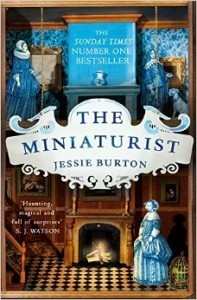 I was recently reading The Miniaturist by Jessie Burton. I can remember with great pleasure the early scenes, the loving description of the new house where the new wife is to live and its bizarre and expensive counterpart, the miniature house. But once I am concerned about the life or death of Nella's husband I am too busy flipping the pages to sink deep into the words, and although the early part of the book was memorable for me, the latter part was much less so.Plausibility is also an issue here, because real life is not so frenzied. The passages in my own writing where the pages are turning, are also the ones most likely to be in need of a reality check. So I recognise Ms Burton's problem. Thrillers are not renowned for being memorable because a thriller writer has this juggling act all the time - the more unlikely the plot, the more the writer must convince the reader by supplying a slew of specifics, explanatory detail, incontrovertible data. But the same is also true of any other novel, including my own genre of historical fiction.A good novel perhaps should allow the reader passages where the reader must slow and think, and drink in the words, but also produce enough pace to keep readers motivated to carry on. Many novels that have stayed with me are very long. This could be because the length allows depth, and a long novel can have multiple high-points, and corresponding multiple episodes of deepening, where we can take on more detail.
I was recently reading The Miniaturist by Jessie Burton. I can remember with great pleasure the early scenes, the loving description of the new house where the new wife is to live and its bizarre and expensive counterpart, the miniature house. But once I am concerned about the life or death of Nella's husband I am too busy flipping the pages to sink deep into the words, and although the early part of the book was memorable for me, the latter part was much less so.Plausibility is also an issue here, because real life is not so frenzied. The passages in my own writing where the pages are turning, are also the ones most likely to be in need of a reality check. So I recognise Ms Burton's problem. Thrillers are not renowned for being memorable because a thriller writer has this juggling act all the time - the more unlikely the plot, the more the writer must convince the reader by supplying a slew of specifics, explanatory detail, incontrovertible data. But the same is also true of any other novel, including my own genre of historical fiction.A good novel perhaps should allow the reader passages where the reader must slow and think, and drink in the words, but also produce enough pace to keep readers motivated to carry on. Many novels that have stayed with me are very long. This could be because the length allows depth, and a long novel can have multiple high-points, and corresponding multiple episodes of deepening, where we can take on more detail.
 What do you think? And is this a balance that is easy to achieve? A book that does this perfectly, to my mind, is The Book Thief by Marcus Zusak. Page-turning, and memorable.
What do you think? And is this a balance that is easy to achieve? A book that does this perfectly, to my mind, is The Book Thief by Marcus Zusak. Page-turning, and memorable.
 I was recently reading The Miniaturist by Jessie Burton. I can remember with great pleasure the early scenes, the loving description of the new house where the new wife is to live and its bizarre and expensive counterpart, the miniature house. But once I am concerned about the life or death of Nella's husband I am too busy flipping the pages to sink deep into the words, and although the early part of the book was memorable for me, the latter part was much less so.Plausibility is also an issue here, because real life is not so frenzied. The passages in my own writing where the pages are turning, are also the ones most likely to be in need of a reality check. So I recognise Ms Burton's problem. Thrillers are not renowned for being memorable because a thriller writer has this juggling act all the time - the more unlikely the plot, the more the writer must convince the reader by supplying a slew of specifics, explanatory detail, incontrovertible data. But the same is also true of any other novel, including my own genre of historical fiction.A good novel perhaps should allow the reader passages where the reader must slow and think, and drink in the words, but also produce enough pace to keep readers motivated to carry on. Many novels that have stayed with me are very long. This could be because the length allows depth, and a long novel can have multiple high-points, and corresponding multiple episodes of deepening, where we can take on more detail.
I was recently reading The Miniaturist by Jessie Burton. I can remember with great pleasure the early scenes, the loving description of the new house where the new wife is to live and its bizarre and expensive counterpart, the miniature house. But once I am concerned about the life or death of Nella's husband I am too busy flipping the pages to sink deep into the words, and although the early part of the book was memorable for me, the latter part was much less so.Plausibility is also an issue here, because real life is not so frenzied. The passages in my own writing where the pages are turning, are also the ones most likely to be in need of a reality check. So I recognise Ms Burton's problem. Thrillers are not renowned for being memorable because a thriller writer has this juggling act all the time - the more unlikely the plot, the more the writer must convince the reader by supplying a slew of specifics, explanatory detail, incontrovertible data. But the same is also true of any other novel, including my own genre of historical fiction.A good novel perhaps should allow the reader passages where the reader must slow and think, and drink in the words, but also produce enough pace to keep readers motivated to carry on. Many novels that have stayed with me are very long. This could be because the length allows depth, and a long novel can have multiple high-points, and corresponding multiple episodes of deepening, where we can take on more detail.
 What do you think? And is this a balance that is easy to achieve? A book that does this perfectly, to my mind, is The Book Thief by Marcus Zusak. Page-turning, and memorable.
What do you think? And is this a balance that is easy to achieve? A book that does this perfectly, to my mind, is The Book Thief by Marcus Zusak. Page-turning, and memorable.
Published on February 06, 2015 04:33
January 23, 2015
The Historic House Locations for Wolf Hall
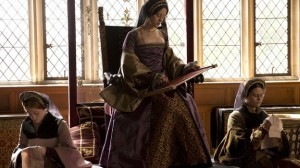
Scene with Anne Boleyn, Wolf Hall
A copy of my National Trust Magazine arrived yesterday and there is an article which details the locations used in the series Wolf Hall. I really loved the first episode, but my NT magazine did not have room for all the properties that will be featured apart from Montacute House. So here, without further ado, are a few images to whet your appetite. If you love historic houses like I do, I strongly recommend that you join the National Trust - free entry to most of these stunning locations. Click on the pictures to get to the National Trust sites for more stunning pictures.
Laycock Abbey was also used for the filming of the Harry Potter films, and was originally an Abbey and a Nunnery. It is now also home to The Fox Talbot Museum of Photography.
Great Chalfield Manor is a Medieval Manor House with a beautiful garden with lily pond and summerhouse.
Chastleton House is an impressive Jacobean Manor House built in 1607.
Horton Court in Gloucestershire was originally built in Norman times, but is now a small manor house.
More details about each house can also be found here.
Montacute House, picture from Wikipedia
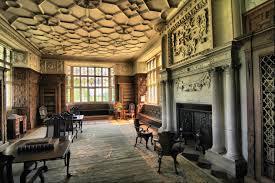
Laycock Abbey

Chalfield Manor
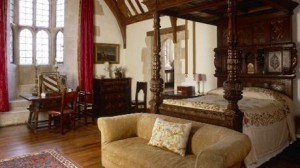
Chastleton House
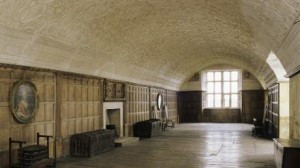
Horton Court

Horton Court
I'm looking forward to seeing the rest of the series and seeing these stunning locations. I'm also eagerly awaiting Mantel's next book, though according to the BBC she has told us all to 'be patient'. The pressure on her must be enormous, and they are very big books. Wonder if she'll be the first Triple Booker Winner?!
Published on January 23, 2015 04:30
November 24, 2014
A Saga Lover's Christmas Stocking - two books to hit the spot

I was lucky enough to attend the launch of Freda Lightfoot's new book, The Amber Keeper, and dived straight in to this gorgeously evocative tale of love and treachery in the Russian Revolution. Impeccably researched, the book tells of how, in the 1960's, single mother Abbie tries to uncover the reason behind her mother's suicide. The trail leads her back through her grandmother's history as a governess in 1911. Being local to the Lake District I particularly enjoyed all the local references and descriptions of the English Lakes in the sixties, and thought they made a wonderful contrast to the snowy landscape of turn of the century Russia. The characters are well-developed, and the Countess Belinsky and her family provide Abbie's grandmother with much more than she bargained for in terms of danger and deception. Freda Lightfoot's well-written sagas are always a delight to read, and this is no exception, with themes of revenge and jealousy, hidden family secrets and enduring love.

The second book I've been lucky enough to review this week is another treat for saga lovers: Christmas Fireside Stories. Our central heating boiler broke down last week, so we have been surviving by layering extra jumpers, lighting the log fire in the living room, and by carting electric fires from place to place in the bedrooms. So I was able to sit by my log-burner and read this selection of great stories and extracts - a perfect place to enjoy them. The six stories include a poignant re-telling of the 1914 truce during the first World War, expertly re-told by Margaret Dickinson. Although most people know the facts of this event, it was lovely to have it brought skilfully to life in this timely version. My favourite story was 'Christmas at Thalstead Halt' by Annie Murray, in which a shy railway worker finds that a broken down train brings him an unexpected Christmas gift. All the stories were well worth reading and enjoyable, fans of Diane Allen, Rita Bradshaw, Pam Weaver and Mary Wood will find they are well catered for in this anthology. If you like to look back to your childhood Christmases, to paper chains and coal fires, wartime rationing or clogs in the snow, this nostalgic collection hits the spot. The book contains anecdotes from the authors, recipes, and introductory extracts from their novels. AAh, all I need now is another mince pie!
Published on November 24, 2014 03:04
August 26, 2014
The Attraction of the Highwayman Image - with Henriette Gyland
[image error]
Both Henriette Gyland and I have new books out about a female highwayman. Fascinated by finding this out, I invited Henri to come and enlighten us about her novel. Henri's novel is called The Highwayman's Daughter. I asked her:
Did you base The Highwayman's Daughter on a particular highwayman?This is a hard question to answer. Initially I would say “no” but the idea of the highwayman is firmly lodged in our collective consciousness that I probably did base it on a particular highwayman – or a conglomeration of several – without even realising it! In addition to that I wanted to work from the premise of an “ordinary decent criminal”, the otherwise upright character forced into a life of crime due to personal circumstances.
As a writer of romantic fiction it was important for me to maintain the myth and the romance of the highwayman. Of course, the reality was quite different – most highwaymen were ruthless thugs, and many were rapists and murderers too. Some even did it for kicks rather than necessity, like Lady Katherine Ferrers whose gutsiness I can’t help admiring despite her dubious reasons for taking to highway robbery (she was bored, apparently).
Yes, I agree. The myth and romance is what attracts readers to the idea. The reality may have been somewhat different! I had to think hard about how ruthless I wanted my female highwayman to be before I started writing, and I'm interested to know what you think makes a good female highway robber.
She has to be daring, but she can also be frightened. In the 18th century, who wouldn’t be scared of sustaining a wound from a victim determined to protect his (or her) property? Even if the wound itself wasn’t fatal, it could so easily turn septic, and our highway robber would die an agonising death. Then there was the risk of disclosure and being caught which would lead straight to the gallows, with only the rarest chance of a reprieve.
Like any other thief, our female highway robber would also have to be clever enough to dispose of stolen goods without drawing attention to herself and to blend in with everyday life.
From a purely writerly perspective, in order for her to be an effective female heroine, she has to have to have a Good Reason for committing her crimes. Even though she breaks the law and technically threatens innocent people into submission, she still needs a strong moral code.
Yes, I think you're right - the motivation is everything. But with such a compelling female protagonist, how can the hero compete?!
Good question! To avoid the gutsy heroine taking over the story, in my opinion the only way the hero can compete is by having his own strengths. By that I don’t mean physical superiority, although he would likely have that, or an I-must-conquer-this-female attitude, but an inner strength which leaves him in no doubt about who he is and his place in society. However, if he belongs to the upper echelons, he should never pull rank over those less fortunate than himself, including the heroine.
He must be noble, honourable, and even when he makes mistakes, he must possess the courage to admit to these mistakes and do whatever it takes to right those wrongs. Can he break the law too? Sure, but like the heroine he must have a strong moral code.
I have just downloaded The Highwayman's Daughter and I'm looking forward to meeting your characters. I'm hoping that our two heroines don't meet on the road - or there could be a bit of a battle! Fortunately novelists are a bit more polite, and it's been a pleasure to have you here, Henriette.
You can find Henriette Gyland on her WebsiteOn Twitter: @henrigyland or on Facebook
You can never have enough books about Highwaywomen!You may also like:
Both Henriette Gyland and I have new books out about a female highwayman. Fascinated by finding this out, I invited Henri to come and enlighten us about her novel. Henri's novel is called The Highwayman's Daughter. I asked her:
Did you base The Highwayman's Daughter on a particular highwayman?This is a hard question to answer. Initially I would say “no” but the idea of the highwayman is firmly lodged in our collective consciousness that I probably did base it on a particular highwayman – or a conglomeration of several – without even realising it! In addition to that I wanted to work from the premise of an “ordinary decent criminal”, the otherwise upright character forced into a life of crime due to personal circumstances.
As a writer of romantic fiction it was important for me to maintain the myth and the romance of the highwayman. Of course, the reality was quite different – most highwaymen were ruthless thugs, and many were rapists and murderers too. Some even did it for kicks rather than necessity, like Lady Katherine Ferrers whose gutsiness I can’t help admiring despite her dubious reasons for taking to highway robbery (she was bored, apparently).
Yes, I agree. The myth and romance is what attracts readers to the idea. The reality may have been somewhat different! I had to think hard about how ruthless I wanted my female highwayman to be before I started writing, and I'm interested to know what you think makes a good female highway robber.
She has to be daring, but she can also be frightened. In the 18th century, who wouldn’t be scared of sustaining a wound from a victim determined to protect his (or her) property? Even if the wound itself wasn’t fatal, it could so easily turn septic, and our highway robber would die an agonising death. Then there was the risk of disclosure and being caught which would lead straight to the gallows, with only the rarest chance of a reprieve.
Like any other thief, our female highway robber would also have to be clever enough to dispose of stolen goods without drawing attention to herself and to blend in with everyday life.
From a purely writerly perspective, in order for her to be an effective female heroine, she has to have to have a Good Reason for committing her crimes. Even though she breaks the law and technically threatens innocent people into submission, she still needs a strong moral code.
Yes, I think you're right - the motivation is everything. But with such a compelling female protagonist, how can the hero compete?!
Good question! To avoid the gutsy heroine taking over the story, in my opinion the only way the hero can compete is by having his own strengths. By that I don’t mean physical superiority, although he would likely have that, or an I-must-conquer-this-female attitude, but an inner strength which leaves him in no doubt about who he is and his place in society. However, if he belongs to the upper echelons, he should never pull rank over those less fortunate than himself, including the heroine.
He must be noble, honourable, and even when he makes mistakes, he must possess the courage to admit to these mistakes and do whatever it takes to right those wrongs. Can he break the law too? Sure, but like the heroine he must have a strong moral code.
I have just downloaded The Highwayman's Daughter and I'm looking forward to meeting your characters. I'm hoping that our two heroines don't meet on the road - or there could be a bit of a battle! Fortunately novelists are a bit more polite, and it's been a pleasure to have you here, Henriette.
You can find Henriette Gyland on her WebsiteOn Twitter: @henrigyland or on Facebook
You can never have enough books about Highwaywomen!You may also like:

Published on August 26, 2014 11:36
August 20, 2014
The Advantages of a Book Blog Tour
I'm about to embark on another Virtual Tour with my new YA book, Shadow on the Highway (FREE on Kindle this week only! US UK )
This will be the third blog tour I have done with my historical fiction books, and I'm really grateful to all the bloggers who are participating, and to Amy Bruno of HVFT who organises the schedule and generally keeps me on track. My first blog tour I organised myself, but it was enormously time-consuming, and now I hire someone to do the prep, which leaves me more time to concentrate on writing guest posts and promoting the tour.
I thought I would highlight the advantages of doing a blog tour, given that there are now so many blogs that readers are often overwhelmed by the sheer number, and end up not reading any at all.The main point I want to let authors know, is that if you are looking for the blog tour to hard-sell your books, then you will probably be disappointed.
Blog Tours build sales slowly as they are about relationships built over time with your readers, and about what is now called in the trade your 'author platform'. (Most people I know still think of a platform as a place to catch a train!) Virtual Tours are a chance not only to put your book out there online (where every body is, these days it seems), but to listen to the feedback from readers. Book Review bloggers read to a punishing schedule, often many books every month, and as such they are expert readers. They will soon spot any flaws in your book, and when several of them all say the same thing it is a chance for you, the writer, to address the problem in your writing.
I am excited to hear whether bloggers will notice a difference between my adult and teen titles, and what they will highlight as a great part of their reading experience.
For me as an an author the main advantages of a Book Blog Tour have been:• To get reviews and feedback from many different people, which tells me what the people who are attracted to my genre of fiction like and expect, and often quite clearly what they don't like!
• To gain exposure on different blogs to their loyal followers, who are all people who read and are interested in books enough to read a Book Blog
• That often, reviewers post up their reviews on Amazon, Goodreads and other online sites, leading to a higher profile for the author and more attention to older titles
• A chance to chat to readers through comments on my guest posts and bring more life and vibrancy to the book blog hosting me
Whilst on the book tour it is tempting to tweet every review, highlight them all on facebook, and generally drive your regular readers crazy. Of course your hosts on the tour will expect you to promote their blog whilst you guest with them, but this can be a turn-off for your regular followers. The strategy that works best for me is to highlight each blog once, and then return to promote it after the blog tour has finished, so that way you can keep in touch with bloggers after the tour has ended. I do this, even if the blogger has left me an unfavourable review - after all, they committed their time to reading your book above other choices they may have had.
A Book Blog Tour is a wonderful way to increase your networking profile on Google and in search engines, and as a platform builder it is second to none. People are still reading my posts from my first blog tour which was three years ago, and I am returning to some book bloggers for the third time, proving that they are looking forward to sharing my latest book with their readers.
You will find the schedule for my tour if you click on the banner -
TRY 'SHADOW ON THE HIGHWAY' FREE! Yes, I'd like to gallop by moonlight along an English highway Yes, I'd like to shout 'Stand and Deliver!' in the USA
This will be the third blog tour I have done with my historical fiction books, and I'm really grateful to all the bloggers who are participating, and to Amy Bruno of HVFT who organises the schedule and generally keeps me on track. My first blog tour I organised myself, but it was enormously time-consuming, and now I hire someone to do the prep, which leaves me more time to concentrate on writing guest posts and promoting the tour.
I thought I would highlight the advantages of doing a blog tour, given that there are now so many blogs that readers are often overwhelmed by the sheer number, and end up not reading any at all.The main point I want to let authors know, is that if you are looking for the blog tour to hard-sell your books, then you will probably be disappointed.
Blog Tours build sales slowly as they are about relationships built over time with your readers, and about what is now called in the trade your 'author platform'. (Most people I know still think of a platform as a place to catch a train!) Virtual Tours are a chance not only to put your book out there online (where every body is, these days it seems), but to listen to the feedback from readers. Book Review bloggers read to a punishing schedule, often many books every month, and as such they are expert readers. They will soon spot any flaws in your book, and when several of them all say the same thing it is a chance for you, the writer, to address the problem in your writing.
I am excited to hear whether bloggers will notice a difference between my adult and teen titles, and what they will highlight as a great part of their reading experience.
For me as an an author the main advantages of a Book Blog Tour have been:• To get reviews and feedback from many different people, which tells me what the people who are attracted to my genre of fiction like and expect, and often quite clearly what they don't like!
• To gain exposure on different blogs to their loyal followers, who are all people who read and are interested in books enough to read a Book Blog
• That often, reviewers post up their reviews on Amazon, Goodreads and other online sites, leading to a higher profile for the author and more attention to older titles
• A chance to chat to readers through comments on my guest posts and bring more life and vibrancy to the book blog hosting me
Whilst on the book tour it is tempting to tweet every review, highlight them all on facebook, and generally drive your regular readers crazy. Of course your hosts on the tour will expect you to promote their blog whilst you guest with them, but this can be a turn-off for your regular followers. The strategy that works best for me is to highlight each blog once, and then return to promote it after the blog tour has finished, so that way you can keep in touch with bloggers after the tour has ended. I do this, even if the blogger has left me an unfavourable review - after all, they committed their time to reading your book above other choices they may have had.
A Book Blog Tour is a wonderful way to increase your networking profile on Google and in search engines, and as a platform builder it is second to none. People are still reading my posts from my first blog tour which was three years ago, and I am returning to some book bloggers for the third time, proving that they are looking forward to sharing my latest book with their readers.
You will find the schedule for my tour if you click on the banner -

TRY 'SHADOW ON THE HIGHWAY' FREE! Yes, I'd like to gallop by moonlight along an English highway Yes, I'd like to shout 'Stand and Deliver!' in the USA
Published on August 20, 2014 02:16




